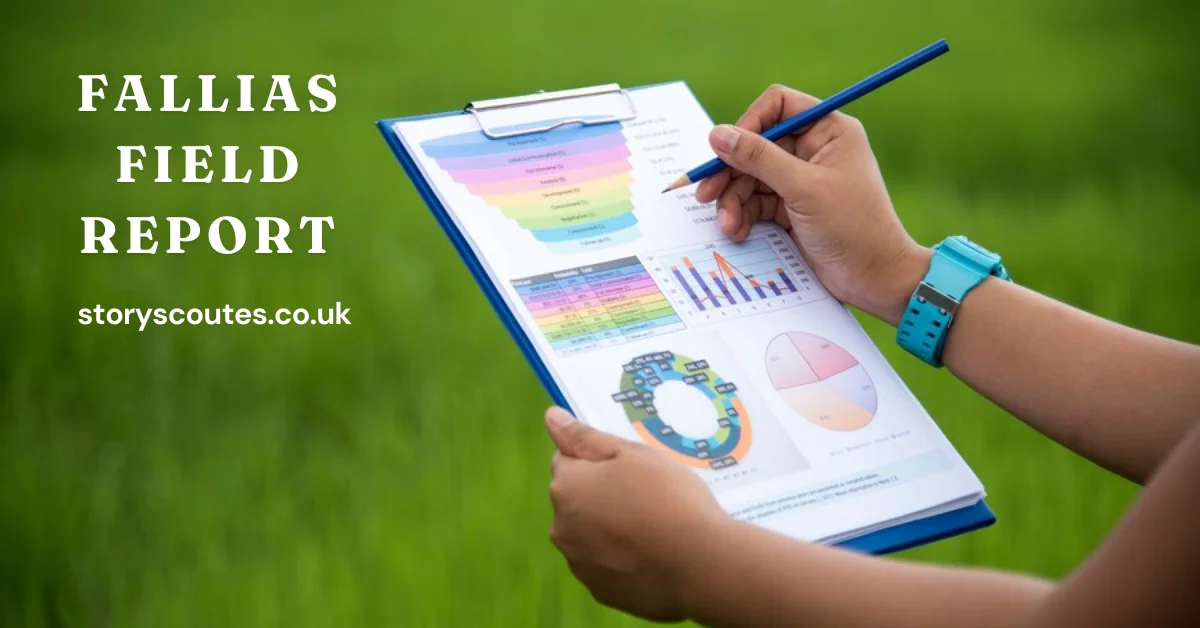Fallias Field Report – A Comprehensive Guide to Soil Health and Sustainability
Soil health is a crucial component of agricultural success, environmental sustainability, and food security. The state of our soil impacts everything from crop yields to ecosystem services, making it a vital area of study for scientists, farmers, and environmentalists alike. One of the leading resources in this field is Fallias Field Report, a comprehensive guide that dives deep into the intricacies of soil health and its importance.
In this article, we’ll explore Fallias Field Report in detail, breaking down the key elements of soil health, the best practices for maintaining it, and the broader implications for agriculture and the environment. We will also provide insights that go beyond the existing literature, making this guide not only informative but also essential for anyone interested in sustainable land management.
What is Fallias Field Report?
Fallias Field Report is a detailed guide designed to help farmers, agronomists, and environmentalists understand and improve soil health. It emphasizes the importance of maintaining healthy soil ecosystems, which are essential for sustainable farming practices, environmental preservation, and food security. The report offers a wealth of information on soil composition, structure, and function, along with practical advice on how to assess and enhance soil health.
The report is widely recognized for its thoroughness and practical application, making it an invaluable resource for those who rely on soil health for their livelihoods or are involved in environmental conservation.
The Importance of Soil Health
Soil health refers to the condition of the soil in terms of its biological, chemical, and physical properties. Healthy soil supports plant growth, regulates water, sustains biodiversity, and helps mitigate climate change by sequestering carbon. Fallias Field Report stresses that maintaining healthy soil is not just about boosting crop yields; it’s about ensuring the long-term viability of our food systems and natural environments.
Key Components of Soil Health
The Fallias Field Report outlines several key components of soil health, each of which plays a critical role in maintaining a productive and sustainable agricultural system. These components include soil structure, nutrient content, organic matter, water retention, and biological activity.
1. Soil Structure
Soil structure refers to the arrangement of soil particles into aggregates, which affects the soil’s ability to hold water, support root growth, and allow air to circulate. Good soil structure is essential for plant health and productivity. According to Fallias Field Report, practices such as reduced tillage, cover cropping, and organic amendments can help improve soil structure.
2. Nutrient Content
Nutrients are the building blocks of plant growth. Fallias Field Report emphasizes the importance of maintaining balanced nutrient levels in the soil to ensure optimal plant health. This includes not only macronutrients like nitrogen, phosphorus, and potassium but also micronutrients like zinc, iron, and manganese. Regular soil testing and the use of organic fertilizers can help maintain the necessary nutrient balance.
3. Organic Matter
Organic matter is a crucial component of soil health. It improves soil structure, increases water retention, and provides a source of nutrients for plants and soil organisms. Fallias Field Report highlights the importance of incorporating organic matter into the soil through practices like composting, mulching, and cover cropping.
4. Water Retention
Water retention is the soil’s ability to hold water, which is vital for plant growth, especially in dry conditions. Healthy soil with good structure and organic matter content can retain more water, reducing the need for irrigation and helping plants survive during droughts. Fallias Field Report suggests practices like contour plowing and the use of water-efficient irrigation systems to improve water retention.
5. Biological Activity
Biological activity in the soil refers to the presence and activity of microorganisms, earthworms, and other organisms that play a role in breaking down organic matter and recycling nutrients. Fallias Field Report stresses the importance of fostering a diverse and active soil ecosystem to maintain soil health. Practices like reducing chemical inputs and encouraging biodiversity can enhance biological activity in the soil.
How to Assess Soil Health: A Step-by-Step Guide
Fallias Field Report provides a comprehensive approach to assessing soil health. This involves several steps, each designed to evaluate different aspects of the soil’s condition.
Step 1: Visual Inspection
The first step in assessing soil health is a visual inspection. This involves looking at the soil’s color, texture, and structure, as well as the presence of plant roots and soil organisms. Healthy soil typically has a dark color, indicating high organic matter content, and a crumbly texture that allows for good air and water movement.
Step 2: Soil Testing
Soil testing is a more precise way to assess soil health. It involves taking samples of the soil and analyzing them for nutrient content, pH level, and organic matter. Fallias Field Report recommends regular soil testing to monitor changes in soil health over time and to guide management decisions.
Step 3: Measuring Soil Moisture
Soil moisture is a key indicator of soil health, particularly in terms of water retention. Measuring soil moisture levels can help determine whether the soil is able to hold enough water to support plant growth. Fallias Field Report suggests using moisture meters or simple methods like the feel-and-appearance test to assess soil moisture.
Step 4: Biological Assessment
A biological assessment involves examining the presence and activity of soil organisms, such as earthworms, bacteria, and fungi. Fallias Field Report highlights the importance of a diverse and active soil ecosystem for maintaining soil health. Methods like soil respiration tests and microbial biomass measurements can provide insights into the biological activity of the soil.
Step 5: Long-Term Monitoring
Soil health is not static; it changes over time in response to management practices and environmental conditions. Fallias Field Report recommends long-term monitoring to track these changes and adjust management practices as needed. This can involve regular soil testing, visual inspections, and biological assessments.
Best Practices for Maintaining Soil Health
Maintaining soil health requires a combination of practices that work together to support the soil’s physical, chemical, and biological properties. Fallias Field Report outlines several best practices for maintaining and improving soil health.
1. Crop Rotation
Crop rotation is the practice of growing different crops in succession on the same land. This helps prevent the depletion of specific nutrients and reduces the buildup of pests and diseases. Fallias Field Report suggests rotating crops with different nutrient requirements and root structures to promote soil health.
2. Cover Cropping
Cover crops are plants grown primarily to protect and improve the soil rather than for harvest. They help prevent erosion, improve soil structure, and add organic matter to the soil. Fallias Field Report recommends using cover crops like legumes, which can also fix nitrogen in the soil, further enhancing its fertility.
3. Reduced Tillage
Tillage is the process of preparing the soil for planting by mechanically turning it over. While tillage can help control weeds and prepare the seedbed, it can also disrupt soil structure and reduce organic matter. Fallias Field Report advocates for reduced tillage or no-till practices to maintain soil structure and organic matter.
4. Organic Amendments
Organic amendments, such as compost, manure, and mulch, are materials added to the soil to improve its physical and chemical properties. Fallias Field Report emphasizes the use of organic amendments to increase organic matter content, improve soil structure, and provide nutrients for plants and soil organisms.
5. Integrated Pest Management (IPM)
Integrated Pest Management (IPM) is a holistic approach to pest control that combines biological, cultural, mechanical, and chemical methods. Fallias Field Report recommends IPM as a way to reduce the reliance on chemical pesticides, which can harm soil organisms and degrade soil health.
6. Water Management
Effective water management is crucial for maintaining soil health, particularly in areas prone to drought or excessive rainfall. Fallias Field Report suggests practices like contour plowing, drip irrigation, and the use of water-efficient crops to optimize water use and prevent soil erosion.
The Broader Implications of Soil Health
While Fallias Field Report focuses on practical advice for maintaining soil health, it also highlights the broader implications of soil health for agriculture, the environment, and society as a whole.
Soil Health and Climate Change
Soil plays a critical role in the global carbon cycle, acting as both a source and a sink for carbon dioxide (CO2). Healthy soils can sequester significant amounts of carbon, helping to mitigate climate change. Fallias Field Report discusses the potential for soil management practices to increase carbon sequestration and reduce greenhouse gas emissions.
Soil Health and Food Security
Food security depends on the ability of agricultural systems to produce enough food to meet the needs of the global population. Healthy soils are essential for achieving high crop yields and ensuring the long-term sustainability of food production. Fallias Field Report emphasizes the importance of soil health for food security and the need for policies that support sustainable soil management practices.
Soil Health and Biodiversity
Soil biodiversity is a key indicator of soil health and plays a crucial role in ecosystem services such as nutrient cycling, water filtration, and disease suppression. Fallias Field Report highlights the importance of maintaining soil biodiversity to support healthy ecosystems and ensure the resilience of agricultural systems.
Insights and Analysis: Beyond the Report
While Fallias Field Report provides a comprehensive overview of soil health, there are several areas where additional insights and analysis can deepen our understanding of this critical issue.
The Role of Technology in Soil Health
Advancements in technology are transforming the way we manage soil health. Precision agriculture, for example, uses data from soil sensors, drones, and satellite imagery to monitor soil conditions and optimize management practices. These technologies can help farmers make more informed decisions about when and how to apply fertilizers, water, and other inputs, ultimately improving soil health.
Fallias Field Report touches on some of these technologies, but there is potential for further exploration of how they can be integrated into soil health management strategies. The use of machine learning and artificial intelligence (AI) to predict soil health trends and recommend management practices is an emerging area of interest that could revolutionize soil health management.
The Economic Benefits of Soil Health
Investing in soil health can yield significant economic benefits, not only for farmers but also for society as a whole. Healthy soils lead to higher crop yields, reduced input costs, and greater resilience to climate change, all of which contribute to the economic viability of farming operations. Moreover, the environmental services provided by healthy soils, such as carbon sequestration and water filtration, have broader economic implications for society.
Fallias Field Report discusses the importance of soil health for agricultural productivity but could benefit from a deeper analysis of the economic benefits of soil health investments. For example, quantifying the return on investment (ROI) for soil health practices could provide a compelling argument for policymakers and farmers to prioritize soil health.
Policy Implications for Soil Health
Soil health is not just an agricultural issue; it is also a policy issue. Governments play a critical role in promoting soil health through regulations, incentives, and research funding. Fallias Field Report highlights the need for policies that support sustainable soil management practices, but there is room for further exploration of the specific policy measures that can be implemented to promote soil health.
For example, policies that incentivize cover cropping, reduced tillage, and organic farming could encourage more farmers to adopt these practices. Additionally, funding for soil health research and education could help advance our understanding of soil health and develop new technologies and practices for maintaining it.
FAQs About Fallias Field Report
What is the primary focus of Fallias Field Report?
The primary focus of Fallias Field Report is to provide a comprehensive guide on soil health, emphasizing the importance of maintaining healthy soil ecosystems for sustainable farming and environmental preservation.
How can Fallias Field Report help farmers?
Fallias Field Report offers practical advice on assessing and improving soil health, which can help farmers increase crop yields, reduce input costs, and enhance the long-term sustainability of their farming operations.
Why is soil health important for climate change mitigation?
Healthy soils can sequester carbon, helping to reduce greenhouse gas emissions and mitigate climate change. Fallias Field Report discusses the potential for soil management practices to increase carbon sequestration.
What are some best practices for maintaining soil health mentioned in the report?
Best practices include crop rotation, cover cropping, reduced tillage, organic amendments, integrated pest management, and water management, all of which contribute to maintaining and improving soil health.
How does Fallias Field Report address the issue of soil biodiversity?
Fallias Field Report highlights the importance of maintaining soil biodiversity, which is essential for nutrient cycling, water filtration, and disease suppression in agricultural systems.
Can technology play a role in improving soil health?
Yes, advancements in technology, such as precision agriculture and machine learning, are transforming soil health management by providing data-driven insights that help optimize farming practices.
What are the economic benefits of investing in soil health?
Investing in soil health leads to higher crop yields, reduced input costs, and greater resilience to climate change, all of which contribute to the economic viability of farming and the provision of environmental services.
Conclusion
Fallias Field Report is an essential resource for anyone involved in agriculture, environmental conservation, or land management. It provides a comprehensive overview of soil health, offering practical advice and insights that can help improve soil management practices and promote sustainable farming.
However, the importance of soil health goes beyond agriculture. It has broader implications for climate change mitigation, food security, biodiversity, and economic sustainability. By investing in soil health and implementing the practices outlined in Fallias Field Report, we can ensure the long-term viability of our food systems and natural environments.
As we continue to face global challenges like climate change, population growth, and resource depletion, the need for healthy soils has never been more critical. Fallias Field Report offers a roadmap for achieving this goal, providing valuable guidance for farmers, policymakers, and anyone else interested in the future of our planet’s soil.






